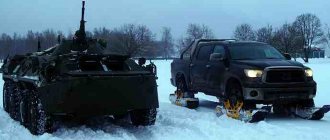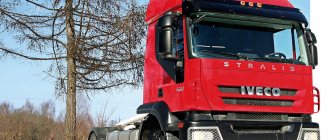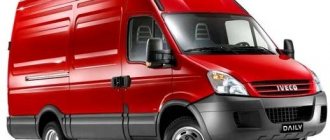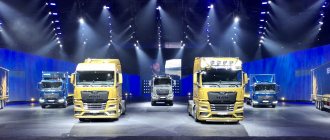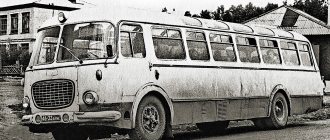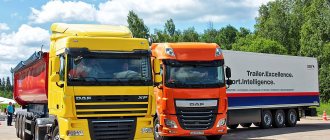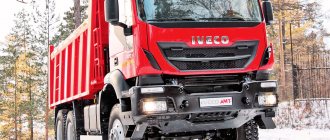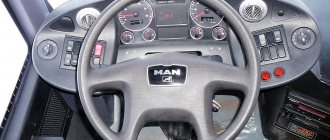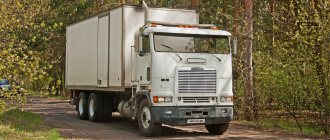To the question “Why did you buy Iveco Stralis?” 99% of owners will answer something like this: “It transports cargo in the same time as a Volvo or Mercedes, and, in fact, it breaks down no more often than them. So why pay more? The logic is ironclad. One of the main advantages of the Iveco Stralis long-haul tractor is indeed an interesting price, compared to competitors from the “big Euro-seven” manufacturers. However, this difference of several hundred thousand rubles is not yet enough to seriously displace traditional leaders in the domestic market. According to Autostat data for 2014, only 8 thousand Stralis vehicles drive on Russian roads. What's the matter?
Iveco Stralis is a family of long-haul tractors produced by the Iveco corporation since 2002. It became a single follower of the Iveco EuroStar and IvecoEuroTech tractors. In the model range it occupies an intermediate position between the medium-tonnage Iveco EuroCargo family and the heavy Iveco Trucker.
To transport various cargoes, not only tilt and isothermal cargo platform vans are installed on the Iveco Stralis chassis. But also high-capacity dump bodies, platforms for transporting passenger cars, tank cars for petroleum products, technical liquids and food products; various types of lifting equipment and special devices for construction and repair work; platforms for transporting large construction and industrial equipment.
As for the modest number of Stralis in our country, several circumstances played a role.
Purpose
The first Iveco Stralis vehicles, released in 2002, were represented by long-haul tractors with a double Active Space cab. A year later, vehicles for regional and local transportation appeared. Chassis for tractors and cars for special superstructures were initially offered with wheel arrangements of 4x2, 6x2, and 6x4. In the third generation of machines, production of which began in 2012, a lot of chassis configurations are offered, including four-axle 8x2 modifications, which are maximally adapted to the production and transport requirements of customers. To transport various cargoes, various types of vans, flatbed and dump bodies, platforms for transporting passenger cars, tanks for technical liquids and food products are installed on the Iveco Stralis chassis. The vehicle can be operated both as part of road trains with a total weight of up to 44 tons, and independently. Iveco Stralis is often used in container transport and the movement of various types of heavy construction equipment. All kinds of lifting equipment and special devices used for construction and repair work are installed on the vehicle chassis.
Price
Options and various power plant options affect the price on the market. Cars in the basic configuration, as well as versions with 420 horsepower engines, will cost carriers 3.3 million rubles.
More powerful Stralis 2022 designs, which are designed for 450 horses, cost 3.6 million rubles.
The price of the richest configurations can reach 4.3 million rubles.
On the secondary market, oddly enough, there are not so many offers for the model. The cost depends on the year of manufacture and condition - from 700 thousand to 2.5 million rubles.
Generations
The Iveco SPA concern assembles trucks at factories located in China, Australia, Brazil and Argentina. Each generation of truck tractor has good factors, including:
- Comfort;
- High resource of power plants;
- Reliable transmissions;
- Low fuel consumption.
Thanks to the meticulous work of engineers and constant improvements, it is a serious competitor to such market monsters as Mercedes-Benz, Man and Volvo.
1st generation Iveco Stralis
In mid-2002, the concern launched mass production of a new type of long-haul tractor. The modification replaced the already well-known EuroStar and EuroTech models.
The new product was an incredible success. It combined the best qualities of tractors from well-known manufacturers. A unique feature was the design of the car and the presence of an automatic transmission. And this is already in the basic configuration. This proposal allowed the company to top the list of market leaders along with Mercedes and Man. The rich configuration of the Iveco Stralis, impressive resource and reasonable price made the car one of the most popular tractors of that time.
A recognizable feature of the car’s appearance was the radiator grille, which took the shape of the letter – U. It was also effectively complemented by a bumper, unusual for experts and carriers, in which head optics were built-in. The first buyers emphasized the large size of the rear-view mirrors, which provide a much better view than in other models. All these advantages allowed the truck to earn the honorary title of Truck of the Year in 2003.
This was followed by the release of two additional modifications. The Iveco Stralis Active Day tractor was designed exclusively for daytime transportation. There was no sleeping space in the cabin, and its dimensions were shortened. And the Active Time configuration was already equipped with an extended cab. It had a choice of 1 or 2 beds.
Restyling of the 1st generation
2007 was marked by changes in the ergonomics and appearance of the machine. The main changes affected the design of the bumper, which included completely new headlights. The main update was the appearance of a new Active Space Cube model in the lineup. It received the most spacious and dimensional cabin.
2nd generation
The next significant change occurred in 2012. The modification began to look more modern. Engineers have retained the famous radiator grille shape, although it has been significantly redesigned. To facilitate the design of the car, the bumper is made of high-quality and lightweight plastic. It, like the previous model, contains headlights, which are now presented in separate blocks.
3rd generation
At the beginning of 2016, the next generation of the popular Iveco model debuted. Three modifications became available to the company’s clients:
- NP is a truck tractor that consumes liquefied gas instead of diesel fuel. Gas has made freight transport much more environmentally friendly;
- XP is an international long-haul tractor. It is designed for long-distance flights and has an increased engine life;
- The standard equipment of the Iveco Stralis 2022 is a regional truck. It can also be used to deliver any type of cargo over short distances.
The new generation was designed based on the Hi-Way configuration. This decision was made by the brand’s management because the original modification had already proven itself to be a reliable special-purpose vehicle. The new product complies with the Euro-6 environmental standard.
Engineers created new electronics, rear suspension design, gearbox and completely redesigned the line of power plants. The braking system has also undergone significant changes.
All of these improvements have made it possible to significantly reduce the level of fuel consumption of Iveco Stralis. The savings amounted to about 11%. It was also possible to install a special Smart EGR system. It optimized fuel combustion.
Iveco Stralis gearbox
As already mentioned, the first-generation model was almost the only modification at the time that was equipped with an automatic transmission. Manual transmissions and automated mechanics were also available to customers. The advantage of the latter option is maximum ease of transmission adjustment.
The following offers are currently available on the market:
- 9-speed manual with servo drive. It is labeled as ZF;
- 6-speed manual transmission, also with ZF servo drive;
- Automatic transmission with 12 gears – EuroTronic 2;
- 6-speed Allison automatic transmission.
Technical characteristics and dimensions
The main technical characteristics of Iveco Stralis include:
| drive unit | 6x2, 4x2; |
| weight | 19 t; |
| lifting capacity | 12.14 t; |
| weight as part of a road train | 50 t; |
| top speed | 90 km/h; |
| top speed | 90 km/h; |
| fifth wheel height | 150 mm. |
However, the equipment differs in dimensions:
| length | 8.81m, 9.04m, 9.44m, 10.61m, 11.65m; |
| wheelbase length | 4.2 m, 4.5 m, 4.8 m, 5.1 m, 5.7 m, 6.3 m, 6.7 m; |
| width | 2.55 m; |
| clearance | 0.25 m; |
| track width front/rear | 2.05/1.82 m. |
Engines
Iveco Stralis engines are six-cylinder in-line 24-valve engines with a common cylinder head for all cylinders, rear-mounted camshaft drive gears and rod valve drive.
There are three options for the working volume of the “Cursor” engines: 7.8, 10.3 and 12.9 liters - respectively, with indexes -8, -10 and -13. One of the features of their design is “wet” cylinder liners, which greatly simplifies repairs, especially premature repairs after emergency cases of failure.
The engine power supply system is “Cursor” - with pump injectors complete with control electronics from the Bosch company. The Cursor family was the first among production engines for heavy trucks to receive variable geometry turbochargers and the problems associated with this advanced unit. Namely: the mechanism for adjusting the position of the blades can jam when carbon deposits are deposited - this is confirmed by the experience of operating Iveco Stralis trucks by domestic carriers.
In its first generation, the first “Cursor” engines were produced in the “Euro-3” version, and then, in 2005, “Euro-4” versions were supplied for cars on the European market, already equipped with urea solution injection systems. The introduction of Euro-5 for modifications of the same engines was also not long in coming. After this, Iveco Stralis began to be in demand both in Germany and in a number of European countries, due to the preferential tolls existing there.
In our country, until 2010, Iveco Stralis was officially presented only with Euro-3 engines. And after this period I immediately went with Euro-5 engines. However, dealers sold the remaining cars with Euro-3 engines that do not require urea filling until mid-2013, when sales of the new Hi-Way model started in Russia.
The engines of this generation of Stralis already met EEV standards, more stringent than Euro 5. On the European market, back in 2012, it transferred all Iveco Stralis engines to the Euro-6 standard (although the official entry into force of these standards in the EEC was scheduled only for 2015).
On the new Cursor diesel engines, instead of traditional pump injectors, the CommonRail fuel supply system was used. Completely new power units were put into production: “Cursor-9” with an unusual cylinder size - a diameter of 117 mm, with a crankshaft crank diameter of 135 mm, and “Cursor-11”, with an equally original ratio of 128 by 144 mm.
The Russian representative office of the Iveco corporation also announced the start of sales with Euro-6 engines, without waiting for these standards to come into use. One of
The reasons for this decision are the absence of an exhaust gas recirculation system on the new Cursor engines and, as a consequence, the danger of acid corrosion of the cylinders when operating on high-sulfur domestic diesel fuel. Another interesting proposal is a gas-fuelled version of the Stralis tractor, with a Cursor-8 engine.
All Cursor power units, except for the gas Cursor-8, are 6-cylinder, 24-valve diesel engines with direct fuel injection, rear-mounted camshaft drive and rod valve drive. The power of the Cursor-8 engines ranges from 310 to 360 hp. (working volume 7.8 l); “Cursor-9” – from 310 to 400 hp. (working volume 8.7 l); “Cursor-10” – from 420 to 450 hp. (working volume 10.3 l); “Cursor-11” – from 420 to 480 hp. (working volume 11.1 l); “Cursor-13” – from 510 to 570 hp. (working volume 12.9 l).
Fuel consumption
Fuel consumption of Iveco Stralis in summer is about 29 liters per 100 km, in winter – 35 liters for the same distance. Depending on the modification, fuel tanks with a capacity of 765 liters and 390 liters can be installed.
Transmission
Gearboxes on Iveco Stralis have always been used only from . In most cases, tractors are equipped with a 16-speed manual gearbox with a two-stage divider and a dual-range planetary range. A minority of cars imported used from European countries have robotic 12-speed gearboxes.
Chassis
The chassis is easy to install and has low operating costs. The supporting structure is made of high-strength steel, the suspension is pneumatic or mechanical. The equipment can be equipped with full or rear air suspension, controlled via the ECAS system, as well as automatic equipment responsible for leveling and height adjustment. It is characterized as an elastic and highly mobile system, capable of providing the required clearance, regardless of the degree of congestion.
The rear axle of the Iveco Stralis tractor unit is equipped with a single final drive, and the gear ratio can be selected. To reduce sway when driving, four adjustable air springs are installed.
The tractor can be equipped with a frame with a thickness of 6.7 mm or 7.7 mm, which ensures high-quality work in difficult conditions.
Suspension and braking system
The front suspension of Iveco Stralis long-haul tractors is made, as a rule, on leaf springs, and the rear suspension is pneumatic four-cylinder. For various modifications of truck tractors, the height of the Iveco Stralis coupling device varies from 950 to 1250 mm. The Stralis family also includes low chassis for special applications, equipped with air suspension and low-profile tires. A variant of the car designated “CT”, with a wheelbase of 550 mm, has a strongly curved front axle beam due to the low position of the frame. The brakes on all wheels are ventilated disc brakes with an anti-lock braking system.
Form follows function
Features of the exterior design of the new STRALIS cabin with reduced aerodynamic drag underline its uniqueness.
As for the front, what immediately catches your eye is the new central radiator grille, modified side deflectors, optimized bumper design and headlights with LED daytime running lights and xenon headlights.
The new STRALIS also has a large space under the windshield where you can place your company name.
The cabin lines of the new STRALIS have been redesigned to achieve an excellent drag coefficient - one of the main factors influencing energy efficiency (at a speed of 85 km/h, 40% of the fuel consumed is spent overcoming air resistance). By improving the drag coefficient by 3%, we reduce cabin noise and achieve significant fuel savings on long-distance trips.
And for cars that are mainly used on highways, you can order a special aerodynamic kit with an adjustable roof spoiler and strong side deflectors, which further reduces fuel consumption.
Cabin
Iveco Stralis trucks are equipped with four types of cabs:
- “AD” (“Active Day”) – a narrow cabin without a sleeping bag with a low roof;
- “AT” (“Active Time”) – a cabin with a compact berth, with a low or high roof;
- “AS” (“Active Space”) – a spacious cabin, with a high roof and increased internal volume, for long-distance and international transport.
- “ES” – “Active Space” cabin in a luxury configuration, with an increased level of comfort.
In Active Space cabs, the driver is more like an operator of electronic systems: the multiplex wiring diagram is built on the principle of “arm's length ergonomics”. The driver's seat is comfortable and sprung, the passenger's seat is swivel. The steering column is adjustable vertically and tilt. There are plenty of compartments for personal items in the cabin. Plastic interior parts are precisely matched to each other, and the reliability of the storage compartment doors is ensured by “furniture” hinges.
For ease of movement around the cabin, the floor-mounted gearshift lever can be rotated 180 degrees. The engine tunnel is located quite low, which also does not impede movement around the cabin. The electronic control system checks the correct gear setting when starting the engine.
If the machine is equipped with a EuroTronic robotic gearbox, the gears are changed using a button on the joystick. The number of the gear to be switched is displayed on the liquid crystal display installed on the instrument panel.
Everything in the cabin is thought out not only for work, but also for relaxation. By simple manipulations with the lower shelf, the cabin can be turned into a compartment with a convenient table. The basic package of the Stralis also includes a set of adjustable spoilers, which not only look stylish, but help save fuel by improving the aerodynamics of the car. The base also comes with air conditioning and electric windows (which are installed for an additional fee on a number of cars of this class).
In addition, Iveco Stralis tractors are supplied with central locking with an immobilizer, a central lubrication system, electrically controlled and heated mirrors, a heated fuel filter-water separator, a heated fuel tank, manual air conditioning, an audio system with 6 speakers and grilles headlights
Steering and instrument panel
The high performance of the Iveco Stralis is due to its improved and ergonomic controls. The IVECONNECT system allows you to control all systems, including the radio, navigator, and increases the comfort of parking. There is a seven-inch monitor on the instrument panel for setting parameters.
Control panel and touch display
The instrument panel and center console are located side by side and contain all the necessary controls. The gearshift knob is ergonomic, and the handbrake is controlled from the front console.
A large number of compartments for things allows you to feel comfortable in the cabin, where every thing has its place.
The engine tunnel of the Iveco Stralis tractor is located quite low, which does not impede movement around the cabin. The electronic control system checks the correct gear setting when starting the engine.
What drivers say about working for Iveco Stralis
Negative reviews from drivers can only be found about the first generation Iveco Stralis. In addition to problems with electrical wiring, there is evidence of damage to the front shock absorbers; engine turbine; about excessive consumption of engine oil. It is noted that the sound insulation of the cabin in Iveco is worse than in Mercedes, Volvo and DAF.
However, in the next generations, Iveco Stralis, according to drivers’ reviews, is no longer inferior to other “Europeans” either in reliability or in operating comfort. Many drivers note the comfortable and soft suspension, reliable rear axle and more complete equipment compared to its competitors.
The instrument panel and center console are located side by side, all the necessary controls are conveniently located and always at hand. The gearshift knob is ergonomic, and the handbrake is controlled from the front console. A large number of compartments for things allows you to feel comfortable in the cabin, where you can choose its own place for each item.
“The trailer is curtain, so sometimes we overload the car up to 25-27 tons without being particularly scrupulous. Consumption per circle is 32-34 liters. It consumes 35 liters per hundred only with an overload of over 30 tons, but we don’t force the machine, we don’t constantly drive systematically with an overload.”
The “ZF” gearbox for acceleration to 60 will surprise many passenger cars, and is also very reliable and convenient. I was worried about winter use, but the locking works perfectly, and the car behaves excellently on the Karelian strewn roads.”
“At the moment, Stralis has already covered 332,000 km. The odometer shows 790 thousand km and the nozzles on the injectors will probably need to be replaced soon, as the engine has become noticeably rougher. There were no problems with the wiring at all, although many people say that it is about to give you problems, but the truck is being used and nothing happens. The only thing that happened was that after we drove 60 thousand and the mileage was a little more than 500 thousand km, the speed sensor failed - we replaced it ourselves, the sensor itself cost 8,600 rubles. The brake pads were changed once, after a mileage of 280 thousand km. The asking price is 5 thousand rubles per axle.”
Vehicle modification designation system
It is relatively easy to read. For example, the modification “ AT440S46 T/P RR” means: a two-axle tractor “Stralis Hi-Road”, designed to work as part of a road train with a gross weight of up to 44 tons, with a “Cursor-10” engine with a power of 460 horsepower , with rear air suspension and in the “for Russia” version (with a reinforced frame and rear axle). In order. The first two letters indicate the cabin type: AT (Active Time). The following is the total weight of the road train (in quintals). The letter S next stands for "Stralis". The two numbers indicated after it are the engine power in tens of horsepower. The fifth group of symbols contains the letter “T” (tractor tractor), and then the letter P, indicating rear air suspension. And at the end, RR is a designation for particularly durable design, a reinforced frame for bad roads and regular overloads.
In the VIN number of Iveco Stralis tractors, the first three letters are always “WJM”. This is a code registered with the German company Magirus AG. The place of assembly of the car can be determined by the sign on the 11th position of the VIN number - the German plant in Ulm corresponds to the number 4, and the Spanish plant in Madrid corresponds to the letter C.
Until 2013, most Iveco Stralis tractors were produced in Germany, but then large-capacity trucks of this brand began to be assembled only in Spain. Their production was concentrated in a single plant in Madrid.
Chassis
Iveco Stralis was originally developed according to the company's small budget. All parts and design of units had to be reduced in price. This was done not only to simply make it cheap, but also to make the car as easy to maintain as possible and inexpensive to purchase.
Taking into account cost minimization, the truck frame is incredibly strong. The use of high-quality materials made it possible to create a reliable and functional chassis.
According to the operating characteristics of the machine and the configuration, you can choose the most suitable type of suspension:
- Mechanical;
- Pneumatic.
Of course, improved ride quality is observed with the Iveco Stralis pneumatic suspension. It can be either posterior or full. Both variants are regulated by ECAS.
The braking system is practically no different from competing models. It is represented by disc mechanisms on all wheels and is controlled by an electronic system. Many carriers have tested the effectiveness of brakes in emergency situations.
The total weight of the model is 19 tons. Load capacity is more than 12 tons. The nominal weight of the Iveco road train was about 50 tons.
Typical problems and breakdowns
Most of the complaints were noted about first-generation pre-restyling cars, and primarily they relate to malfunctions of electrical equipment. As a rule, repairs come down to replacing contacts and wiring connectors damaged by corrosion, but there are also cases of failure of an expensive electronic control unit (ECU).
Another characteristic problem of the first generation of Iveco Stralis trucks is the breakdown of the rear support bracket of the power unit. Regarding engines, negative reviews took place mainly regarding 8-liter engines: at first, Russian carriers preferred cars with such units for reasons of economy. But regular operation in almost maximum power modes did not contribute to the longevity of the engine, and it had to be returned to the “overhaul” when the mileage was approximately three times less than the declared million kilometers. Subsequently, the “eighth” engines almost ceased to be in demand, and almost every “Stralis” sold in Russia was equipped with a “Cursor-10” engine.
On restyled cars of the second and third generation (i.e., on all cars produced after 2007), the electrical wiring has become much more reliable. And the former torment of the owners in the chilly winter season is a thing of the past. However, many owners of new cars are faced with a more serious defect - accelerated wear of the engine piston group. It has already been described in this article above, from the words of Dmitry Beschastny, RusTransLine. When this problem became widespread, an engine plant in France took action. However, Stralis owners still complain about turbochargers - they have to be changed more often than on tractors of other European brands. The reason for this is coking of the moving ring, due to oil getting into waste due to its high consumption, and, as a consequence, failure of the performance control mechanism.
There have been cases when replacing a turbine in a garage sometimes ends disastrously - “amateur” mechanics may forget to remove the oil from the intercooler and let the engine run wild - then try turning it off when it has an unlimited supply of “alternative” fuel! In the best case, in this situation it will press the valves a little into the piston heads, in the worst case it will crush everything at a loss of up to a million rubles.
But repairs of fuel equipment are required quite rarely - the Bosch pump injectors of Cursor engines have demonstrated resistance to diesel fuel of any quality, including that sold in the Russian outback. The same goes for the transmission. Malfunctions of the ZF gearbox are very rare and downright egregious cases. This 16-speed gearbox works flawlessly, promising to easily outlast the car itself.
On EuroTronic automatic transmissions - many used Stralis were imported from Europe with such gearboxes - after significant runs, attachments fail, in particular pneumatic valves. The only reasonable solution in this case, if you are really unlucky, is to independently search for transmission specialists, note the owners of used Iveco Stralis. Since replacing a set of valves or any other major repair of the EuroTronic gearbox at a dealer service will “eat up” all the profit from transportation for the year ahead.
"Iveco Stralis": the path to Russia
The main thing is that the majority of European-made long-haul trucks came to Russia not in new, but in used form. And in those years when used “Germans” and “Swedes” were purchased en masse by our consumers, the first generation Iveco Stralis were still young and, therefore, expensive. plus, in subsequent years, it was necessary to travel for used cars of this brand not to Germany, but to Italy or Spain, where they are quite widespread. But this was not accepted - why, if Germany is only 2 days away?
Potential consumers from Russia have developed a distrustful attitude towards the quality of the Stralis of the first two generations of production, against the backdrop of the impeccable reputation of the well-known and tested Volvos, Mercedes, MAN, DAF. However, several years later, even Quite large transport enterprises began to purchase Iveco Stralis mainline tractors not in isolated cases, but in whole batches, forming their fleet mainly from them. A more attractive price and, in general, successful operating experience still played a role.
